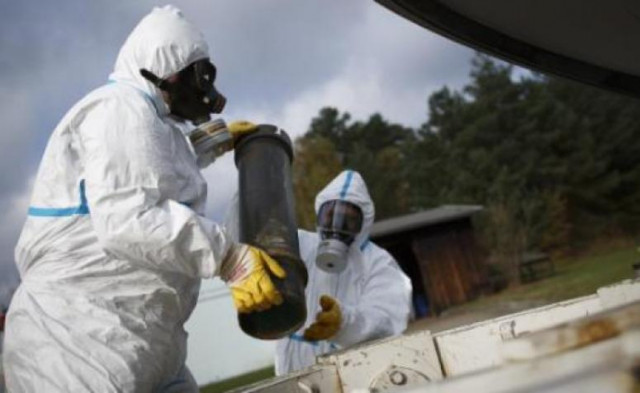Syria 'increasing pace' in chemical removal: watchdog
29.0 percent of the total chemical stockpile have been removed for destruction outside the country.

Syria was to have shipped out most dangerous Category 1 chemicals by December 31 and Category 2 chemicals by February 5. PHOTO: AFP/FILE
But Damascus remained behind schedule as yet another target date loomed next week, ahead of a June 30 deadline to hand over or destroy its arsenal, the Organisation for the Prohibition of Chemical Weapons (OPCW) said in The Hague.
The body's 41-country Executive Council in a statement noted the "increasing pace" of the removal of Syria's stockpile, at the end of a four-day meeting at its headquarters.
The council also "positively noted" the progress that has been made "with respect to eliminating the Syrian chemical weapons programme."
But it als stressed "delays... have occurred about which concerns were expressed."
The combined United Nations-OPCW mission has now verified that nearly 29.0 percent of the total chemical stockpile have been removed for destruction outside the country, the watchdog said.
Earlier this week OPCW head Ahmet Uzumcu told the meeting that Syria had submitted a revised proposal to complete the removal of all chemicals from Syria before the end of April after previously saying it could only complete the job by June.
Syria was to have shipped out most dangerous Category 1 chemicals by December 31 and Category 2 chemicals by February 5.
Syria has also destroyed 93 percent of its stocks of isopropanol, used to make sarin nerve gas, a task that was supposed to have been completed by March 1.
Once Syria has delivered its chemicals to the main port Latakia, they are to be taken by Western warships to a US vessel, the MV Cape Ray, aboard which they will be broken down at sea using hydrolysis, a process expected to take 90 days.
That means the entire disarmament and destruction process may well overrun the June 30 deadline, agreed by Russia and the US last year as part of a plan to avert US-backed military strikes in the wake of deadly chemical attacks outside Damascus blamed by the West on President Bashar al-Assad's regime.
The next target date is March 15 when Syria is supposed to have destroyed its 12 chemical weapon production facilities.
UN Security Council resolution 2118 was passed after a massive chemical weapons attack that killed hundreds in several opposition areas around Damascus in August.
Rebels and the regime exchanged blame for that attack.



















COMMENTS
Comments are moderated and generally will be posted if they are on-topic and not abusive.
For more information, please see our Comments FAQ